Abortion

The Utah Republican is on 11 state ballots. He has no major-party backing, and he’s little known outside of the Beehive State.
But Mormon disaffection with Donald Trump is offering the Provo-born graduate of Brigham Young University a chance to disrupt the outcome in this reliably red state, which has not gone to the Democrats since 1964.

There is no legislative solution to the problem of abortion. There is no president who can end abortion. There is no Supreme Court justice who will solve abortion.
This is not just because we Americans, including we American Christians, have been shouting at each other about abortion for more than 40 years, with no end in sight. It is not just because the conflicting beliefs that people have about abortion are unlikely to change. It is not just because our polarized interest groups and political parties now gain support off of abortion. It is not just because the two “sides” on abortion are roughly balanced and appear likely to remain so.
Abortion is the sad song that never ends. It never ends because at one level it is an intractable human problem, visible in all times and cultures. It goes like this: Fertile heterosexual males and females are needy, passionate, sexual creatures who are drawn to each other and often end up having sex. They do so for all kinds of reasons, some good, some just okay, some terrible. When a fertile male and fertile female are “shooting with live bullets,” sometimes the woman will get pregnant. This is true sometimes when they are using birth control and certainly when they are not using birth control. The God-given power of mammalian reproduction is not easily denied.
Almost every known society has attempted to create systems of social control to limit sexual contact between fertile men and women, in large part because of the procreative power of the mature human body. These have been remarkably comprehensive social systems. They have involved religious, political, legal, moral, communal, and familial efforts to train attitudes, impose constraints, inflame fears, and so on. Always they have involved efforts to limit private contact between sexually mature men and women outside of the socially approved context for procreation—usually, marriage.
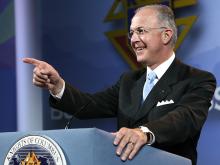
Carl Anderson, leader of the Knights of Columbus fraternal order and one of the most influential lay Catholics in the church, has said that abortion outweighs all other issues in the presidential campaign and Catholics cannot vote for a candidate who supports abortion rights.
Abortion is not “just another political issue” but “is in reality a legal regime that has resulted in more than 40 million deaths,” Anderson told the Knights’ international convention in Toronto in a speech on Aug. 2.

If there is one constant in this unconventional presidential campaign it is the unpredictability — and importance — of the Catholic vote.
Once a reliably Democratic cohort, Catholics have in recent decades swung back and forth between the two parties. And because they represent more than a fifth of all voters, and are concentrated in key Midwestern swing states, the candidate with the most Catholic support has wound up winning the popular vote.

The 2016 Democratic National Convention party platform includes much that religious progressives from multiple faith backgrounds might like. Approved July 25, it calls for expanding LGBT rights, combating climate change, and narrowing the income gap. Here are some of the hot-button social proposals.

In a section titled “Defending Marriage Against an Activist Judiciary,” Republicans say they “condemn” the Supreme Court’s ruling in Obergefell v. Hodges, which made same-sex marriage the law of the land. Religious conservatives from several denominations also have opposed this ruling as the work of “activist judges,” a charge and a term echoed in the platform.
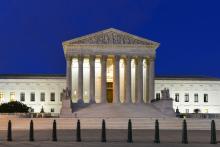
The Supreme Court struck down Texas’ restrictive abortion laws on June 27 in one of the most important abortion-related cases in years.
The Court ruled 5-3 in the case known as Whole Woman’s Health v. Hellerstedt, which served to clarify the 1992 decision Planned Parenthood v. Casey. That case concluded that while the states are free to regulate abortion, they cannot place an “undue burden” on women’s constitutional right to abortion.

The United Methodist Church General Conference convenes once every four years to make policy decisions and set the direction for the denomination.
Beginning May 10, 864 delegates, half of them clergy, will converge on the Oregon Convention Center in Portland for 10 days for the General Conference. More than 40 percent of those delegates will come from outside the U.S.

The news that Planned Parenthood CEO Cecile Richards will speak at Georgetown University reignited a perennial debate about freedom and identity in religious universities, particularly Catholic institutions.

Donald Trump sparked outrage across the ideological spectrum with a call to punish women who obtain abortions if the procedure is banned. Later, however, Trump clarified his position, saying in a campaign statement that, if abortion is banned, “the doctor or any other person performing this illegal act upon a woman would be held legally responsible, not the woman. The woman is a victim in this case as is the life in her womb.”
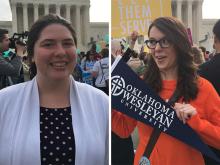
Amid the helium balloons, dance music, chants, and counterchants, Katie Stone and Katie Breslin spelled out their opposing views outside the Supreme Court as the justices inside heard one of the most contentious cases of the year. The two 20-something Christians, both motivated by faith, say the justices’ ruling in Zubik v. Burwell could affirm or weaken the most basic of rights. The case asks whether religious nonprofits must comply with the Affordable Care Act’s contraception mandate, or whether it violates the federal law that sets a high bar for government infringement on religious rights.
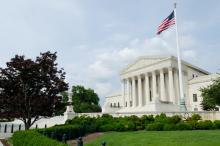
In a landmark abortion case, the Supreme Court — which is down to eight justices — may be evenly split. With Antonin Scalia’s passing, the highest court in the land is now composed of four liberal justices, three conservatives, and the unpredictable Anthony Kennedy.

The Supreme Court takes up its most far-reaching case on abortion rights in nearly a quarter century March 2, with the fate of abortion restrictions in many states on the line. Depleted by the death last month of Justice Antonin Scalia, the eight-member court will consider a challenge mounted by Texas abortion clinics against a law that threatens to leave only 10 clinics operating in a state with 5.4 million women of reproductive age.

With the abortion debate continuing to gather steam, evangelical church leader César Augusto of the Source of Life Church in Goias, central Brazil, advised women last week to avoid becoming pregnant, while Cardinal Odilo Scherer, the Roman Catholic archbishop of Sao Paulo, told women in a BBC interview to “view (babies with microcephaly) as a mission.”

Speaking to reporters on February 18 on the way back from Mexico, Pope Francis weighed in on the outbreak of Zika virus in Latin America.
When asked whether birth control or abortion could be considered a "lesser evil" in the face of the virus, Francis condemned abortion as evil, but offered a more ambiguous response about birth control.

The discovery of a sexually transmitted case of the Zika virus is already reverberating in Latin America. In Brazil, at ground zero of the Zika virus outbreak, the Health Ministry issued new guidelines for pregnant Brazilians, including cautions to use condoms and abstain from sex or even kissing. Activists are also weighing in, calling for legalizing abortion of deformed fetuses. But an important voice with the potential to influence the debate has said relatively little on the topic thus far: the Catholic Church.

“We should never talk about ‘therapeutic’ abortion,” the cardinal said in his homily, according to Honduran media reports.
“Therapeutic abortion doesn’t exist,” he said. “Therapeutic means curing, and abortion cures nothing. It takes innocent lives.”

Michelle Higgins has been making waves lately. A leader in the #BlackLivesMatter movement, she recently addressed a gathering of 16,000 evangelical students at an InterVarsity conference in St. Louis, during which she urged them to back the movement.

In the Catholic Church, a jubilee — or a holy year — is a religious event that involves the forgiveness of sins, as well as reconciliation. But the idea of a jubilee dates back to the Bible: “And you shall sanctify the fiftieth year, and proclaim freedom throughout the land for all who live on it,” Leviticus 25:10. For the ancient Israelites, the jubilee was a time properties were returned to their original owners or legal heirs, slaves were set free, and creditors were barred from collecting debts.
Pope Boniface VIII in 1300 declared the first Christian jubilee, beginning with the opening of the Holy Door, an entrance to St. Peter’s Basilica, usually blocked, through which pilgrims can enter. Other holy doors are also opened for this jubilee in Rome and around the world for the first time; the year ends when they are closed.
On Nov. 29 Pope Francis opened a door at the cathedral in Bangui, the capital of the Central African Republic, as a symbolic start to the Holy Year.
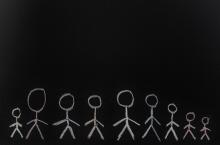
IN OCTOBER, China’s Communist Party leadership announced the end of its nearly 40-year-old “one child” policy, announcing that all married couples could now have two children.
The one-child policy in China was established by Deng Xiaoping in the mid-1970s, first as a voluntary program, then as federal policy. He said it was necessary to make sure that “the fruits of economic growth are not devoured by population growth.” His tool for ensuring economic growth was the large-scale control of women’s bodies. The results have been well-documented: massive numbers of coerced abortions and sterilizations and women with “unapproved” pregnancies avoiding prenatal medical care for fear of such coercion. Women have been and continue to be intensely traumatized by a government policy that is indifferent to their pain.
This policy has also disrupted the gender balance in China. The introduction of ultrasound technology that easily identifies the baby’s gender in utero has led to female feticide—sex-selective abortions. Millions of little girls are dead because they were girls and not boys. Women are aborting their daughters because of their shared gender. What does this do to women’s own self-esteem and self-image?
This is not a glitch in China’s system of population control, but a central feature of it. If you have 50 women and one polygamous man, you can have many babies at once. But if you have 50 men and one woman, you get no more babies than if you have only one fertile man and one woman. If reducing the overall number of people is your goal, then targeting females gets you more bang for the buck, so to speak.